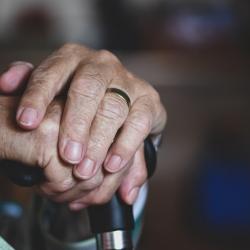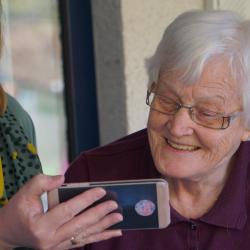8 Safe & Effective Exercises for Older People
Experts recommend getting at least 150 minutes/week of physical activity, which can include aerobic exercises, strength exercises, and balance exercises. Exercising while aging has shown to help prevent disease, lower the risk of falls, improve mental health and well-being, strengthen social ties, and improve cognitive function in older adults. It also helps decrease risk of diseases like cardiovascular disease, stroke, diabetes, and some types of cancer.
Alternatively, lack of physical activity is associated with an increase in percentage of body fat and decline in lean body mass, leading to skeletal and muscle weakness or problems. It can also make daily living activities more difficult.
Most of us know the key to maintaining quality of life, health, and physical function is physical activity and exercise, but as our bodies change, it’s important to be aware of any limitations and know how to exercise safely. Working with a professional, like a personal trainer, can be beneficial because they can help ensure you’re doing the right exercises for you and your goals with the right form to prevent injury.
Additionally, there are things you can do yourself to maintain proper physical activity. Here are the top eight most effective and safe exercises for older adults.
Best exercises for seniors
1. Walking
Walking is the least stressful and most accessible forms of exercise. Experts recommend getting as close to 10,000 steps per day as possible to reap the most benefits. Not only does walking strengthen muscles and help with maintaining a healthy weight, but it can also lower the risk of heart disease, stroke, diabetes, and some cancers. Walk a trail through a park or go with a friend or take your pet for a stroll through the neighborhood. Find an audiobook, playlist, or podcast you enjoy to help pass the time and make your walk more enjoyable.
2. Water aerobics
Some examples of water aerobic exercises include aqua jogging, flutter kicking, leg lifts, water pushups, and arm curls. The buoyancy of the water puts less stress on your joints, so water aerobics is particularly helpful for those with arthritis or other forms of joint pain. The natural resistance also eliminates need for weights or other equipment. Additional benefits include helping to improve flexibility, balance, and strength.
3. Yoga
Yoga or chair yoga, which provides less stress on muscles, joints, and bones, are great exercises for older adults. Not only is yoga low impact, but it also improves muscle strength, mobility, balance, and flexibility. Plus, it can improve your mental health and allow you to get better sleep at night, which has several benefits. Yoga exercises include overhead stretch, seated cat and cow stretch, seated mountain pose, and seated twist, though you can go to a yoga class or find videos online for free to follow for more instruction.
4. Pilates
Like yoga, Pilates is low-impact strength training, but the focus is on core stability. You can also use a reformer, which is the machine that uses springs, bars, and straps for additional resistance. Other equipment includes mats, Pilates balls, or other accessories. The focus on breathing, alignment, concentration, and core strength provides a number of benefits to the body, both physically and mentally.
5. Resistance band workouts
Resistance bands are strips of rubber that stretch and can add resistance to workouts with little stress on your body. They are relatively cheap to purchase and can be used at home or in the gym. Using resistance bands helps strengthen your muscles and core, which can help with mobility and balance. They also challenge muscles in ways you may not be able to with equipment-free training.
6. Bodyweight workouts
One of the best ways to strengthen your muscles and counteract the effects of muscle atrophy is through bodyweight workouts. They are also the most affordable, as it only requires your body, (and potentially a mat). Examples of bodyweight exercises include chair squats, single leg stands, wall pushups, and stair climbing/step-ups.
7. Cycling
Cycling is ideal for those who want to improve leg strength but can’t run or do other high-impact sports. Cycling helps improve heart health, metabolic health, and cognitive performance, so you may want to incorporate cycling into your weekly routine. Go on light bike rides with family or friends or try indoor cycling with a stationary bike.
8. Dumbbell strength training
Dumbbell training can help alleviate symptoms of diabetes, osteoporosis, back pain, and depression. It can also lead to higher metabolism and enhanced glucose control. Dumbbells allow you to isolate muscle groups to strengthen while improving balance and flexibility, but these exercises must be performed with the proper precautions. Start with light weights and do a few reps at a time. Avoid going overboard and stop if you start to feel pulling or pain. Examples of these exercises include bent over row, triceps extensions, bicep curl, overhead press, and front raise.
Exercises older adults should avoid
Exercise is good as we age, but the wrong types or too much exercise can actually do more harm than good. Some exercises even put an unhealthy strain on older adults with joint pain, atrophied muscles, or issues with balance. Avoid exercises like:
- Squats with dumbbells
- Bench press
- Leg press
- Long-distance running
- Deadlift
- High intensity interval training
- Rock climbing
Working with a personal trainer can help ensure you’re doing the right types of training for your body and needs without overdoing it and causing injury.
Safety tips for exercising
- Wear the right clothing and shoes to reduce the risk of injury and maximize benefits from a workout.
- Start slow. The start and end of your exercising should be slower and less intense. As you begin, warm up your body and let heart rate start to increase. Be sure to stretch before and after.
- Stop at the first sign of pain or abnormal discomfort, including spiking heart rate or dizziness.
- Break exercises down into small, short chunks and choose workouts you can manage. They don’t have to be super difficult to be effective.
- Use proper form. If you aren’t sure what that is, ask a personal trainer or do some research online to learn more. This can help you avoid injury.
More to Read:
Previous Posts:











